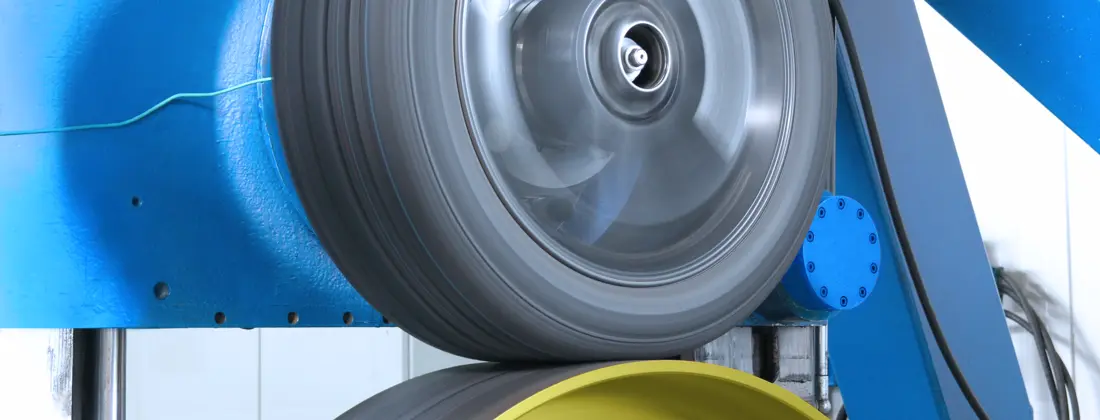ISO 23741 Tyre Bead Unseating Resistance Testing
The ISO 23741 standard provides a method to measure tyre bead unseating resistance, which is crucial for ensuring the structural integrity and safety of tyres. This test evaluates how resistant a tyre’s bead is to being dislodged or “unseated” from its rim during use.
Understanding tyre bead unseating resistance involves comprehending the forces that can act upon the tyre during various driving conditions, such as sudden deceleration, cornering, and off-road scenarios. A robust tyre bead ensures better traction, reduces the risk of accidents, and enhances overall vehicle performance.
The test procedure outlined in ISO 23741 involves subjecting a tyre to a specific load and maintaining it for a defined period. The specimen is then subjected to a pull force designed to simulate real-world conditions that could lead to bead unseating. The apparatus used includes a hydraulic testing machine capable of applying controlled forces while measuring the displacement of the tyre’s bead.
Specimen preparation is critical for accurate test results. Before testing, tyres must be conditioned to specified temperature and humidity levels to simulate real-world conditions. This ensures that any variations in performance are due to the tyre's inherent properties rather than environmental factors.
The process of conducting ISO 23741 testing involves several steps:
- Conditioning the tyres according to standard procedures.
- Mounting the tyres on test-specific rims.
- Applying a specified load and maintaining it for the required duration.
- Subjecting the tyre to a pull force using a hydraulic machine.
- Measuring displacement of the bead under the applied force.
The test results are reported in terms of the maximum force required to displace the bead. This value is crucial for quality assurance and helps manufacturers ensure that their tyres meet stringent safety standards.
Industry Applications: ISO 23741 testing is widely used by tyre manufacturers, automotive original equipment manufacturers (OEMs), and tyre retailers to ensure product reliability and compliance with international safety regulations. The test results are also valuable for R&D teams in identifying areas of improvement in tyre design.
| Industry Segment | Description |
|---|---|
| Tyre Manufacturing | This segment uses ISO 23741 testing to ensure product quality and safety. |
| Automotive Original Equipment Manufacturers (OEMs) | OEMs use this test for compliance with global safety standards and performance benchmarks. |
- The standard is essential for ensuring consistent product quality across different manufacturing processes.
- It helps in identifying potential weaknesses in tyre design that could lead to bead unseating during use.
- The test results are used as a benchmark for comparing the performance of various tyre models and manufacturers.
Customer Impact and Satisfaction: By ensuring that tyres meet ISO 23741 standards, tyre manufacturers can enhance customer satisfaction through improved safety and reliability. This testing process also helps in reducing warranty claims and recalls, thereby improving brand reputation and market trust.
The test results are not only beneficial for the end-user but also for fleet operators who rely on tyres for commercial vehicles. The enhanced durability and performance offered by compliant tyres can translate into operational savings and increased vehicle uptime.
Industry Applications
| Industry Segment | Description |
|---|---|
| Tyre Manufacturing | This segment uses ISO 23741 testing to ensure product quality and safety. |
| Automotive Original Equipment Manufacturers (OEMs) | OEMs use this test for compliance with global safety standards and performance benchmarks. |
| Fleet Management | Fleet operators rely on ISO 23741-compliant tyres to ensure safe operations and reduce maintenance costs. |
- The test results are used as a benchmark for comparing the performance of various tyre models and manufacturers.
- It helps in identifying potential weaknesses in tyre design that could lead to bead unseating during use.
- The standard is essential for ensuring consistent product quality across different manufacturing processes.
Customer Impact and Satisfaction
By ensuring that tyres meet ISO 23741 standards, tyre manufacturers can enhance customer satisfaction through improved safety and reliability. This testing process also helps in reducing warranty claims and recalls, thereby improving brand reputation and market trust.
The test results are not only beneficial for the end-user but also for fleet operators who rely on tyres for commercial vehicles. The enhanced durability and performance offered by compliant tyres can translate into operational savings and increased vehicle uptime.
For quality managers, compliance officers, and R&D engineers, ISO 23741 testing provides a robust framework to ensure that tyre products meet the highest safety standards. This standard is critical for maintaining market competitiveness in an increasingly regulated industry.
Competitive Advantage and Market Impact
Adhering to ISO 23741 ensures that a tyre manufacturer meets the highest safety standards, which can significantly enhance their competitive advantage. This standard is recognized globally and is often a prerequisite for market entry in many countries.
Compliance with ISO 23741 can also lead to increased market share by differentiating products from competitors who do not adhere to such rigorous testing protocols. It demonstrates a commitment to quality and safety, which can attract more discerning customers.
The test results are valuable for R&D teams in identifying areas of improvement in tyre design. By continuously improving bead unseating resistance, manufacturers can enhance product performance and stay ahead of the competition.





